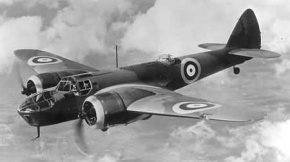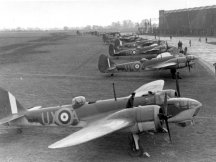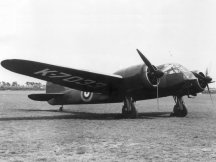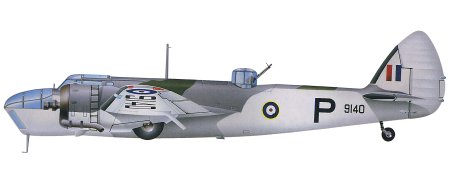
Bristol Blenheim Mk IV
One of the main drawbacks of the Blenheim Mk I was its very cramped navigator's compartment. A new nose with improved accomodation was one of the principal improvements offered by the Mk IV, which replaced the Mk I in production from late 1938.
All but the first 80 Mk IVs had more powerful engines and additional fuel tanks in the wings, which improved their range. Deliveries to RAF squadrons started in March 1939, and after World War II began some were fitted with rear-firing machine guns in a remotely controlled turret under the nose. A fighter variant had a four gun pack under the fuselage.
Blenheim Mk IVs carried out the RAF's first bombing raid of the war and from late 1940 flew many missions over Germany. There was also a Mk V (briefly known as the Bisley) which was even slower than the earlier models but was used by 10 RAF squadrons in North Africa and Far East.
Mark IVs were built under license in Finland, and more than 600 were produced in Canada under the name Bolingbroke. Most were completed as navigation and gunnery trainers; others could be fitted with ski landing gear and used for maritime reconnaissance duties.
Its performance was startling in the early 1930s, but the Blenheim proved inadequate for the demands of World War II combat. By 1941, the bomber was clearly obsolescent, but it had been designated a 'super-priority' type nad thousands more were built. The Mk IV remained in service for a further two years with Bomber Command, and survived even longer in North Africa and the Far East. More than 600 were built in Canada, mainly for training.
 |
 |
 |
| A RAF Blenheim Mk IV was the first British aircraft to cross the German border, making a reconnaisssance flight on 3 September 1939. The following day Blenheims made the first Bomber Command raids. |
After they had outlived their usefulness in Europe, RAF Blenheims were particularly active in the Middle East. Despite their turrets, they were no match for enemy fighters. |
The bulk of Canadian built Blenheims were engaged in training navigators and gunners for the duration of the war. |
|
Bristol Blenheim Mk IV (Technical Specification) |
| Role |
Three-seat light bomber |
| Manufacturer |
Bristol |
| Maximum Speed |
428 kmh (265 mph) |
| Maximum Range |
2,350 km (1,460 miles) |
| Ceiling |
8,310 meters (27,250 feet) |
Weight
Empty
Maximum Takeoff |
4,441 kg (9,770 lbs)
6,532 kg (14,370 lbs) |
Dimensions
Wingspan
Length
Height
Wing Area |
17.17 meters (58 ft 4 in)
12.98 meters (42 ft 7 in)
3.00 meters (9 ft 10 in)
43.57 square meters (469 sq ft) |
| Engines |
Two Bristol Mercury XV nine cylinder air-cooled radial pistol engines each providing 675-kW (905 hp) |
| Armament |
Five 7.7 mm (.303 cal.) machine guns
579 kg (1,274 lb) of bombs |
Photo Gallery
Click here to submit your photo
| Have A Passion For Aircraft? |
Subscribe to our 14 series FREE newsletter
delivered weekly on World War 2 Aircraft factfile... |
| NB:- We hate spam as much as you do, so your email address will NEVER be shared with or sold to anyone else. That's a Guarantee. |
|
|





